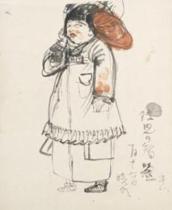Hashimoto Heihachi
Hashimoto Heihachi ( Japanese 橋本 平 八 ; born: October 17, 1897 in Ise ( Mie Prefecture ); died: November 1, 1935 in Tōkyō ) was a Japanese sculptor of the Taishō and Shōwa period . His brother is the poet and photographer Kitazono Katsue .
Live and act
After Hashimoto Heihachi had learned carving from the wood carvers Miyake Masanao II (三 宅 正直 二世; 1848-1922) and Kameda Mokusuke from Uji-Yamada, he went to Tōkyō in 1919 and became a student of Satō Chōzan (1888-1963). From 1924 he exhibited at the exhibitions of Nihon Bijutsuin , called "Inten" (院 展) for short. In 1927 he became an associate member of the Nihon Bijutsuin. In 1935 he was invited to the "Teiten" exhibition. This meant that his submitted works were accepted without any further examination.
Hashimoto lived in seclusion on Mount Asama in Mie Prefecture. The simple Buddhist wooden sculptures of the priest Enkū , who worked in the 17th century, had a great influence on Hashimoto . Hashimoto's works show a mixture of folk art and Eastern symbolism with visionary elements. In this sense he occupies a special position among modern Japanese sculptors.
His representative works include “Naked Boy” (裸形 少年, Ragyō shōnen) and “Playing Angel in the Flower Garden” (花園 に 遊 ぶ 天 女; Hanazono no asobu tennyo).
Individual evidence
- ↑ Laurance P. Roberts: Hashimoto Heihachi
Remarks
- ↑ Teiten ( 帝 展 ) is the abbreviation for the annual state art exhibition ( 帝国 美術展 覧 会 , Teikoku bijutsu-in tenrankai ) between 1919 and 1935.
literature
- Tazawa, Yutaka: Hashimoto Heihachi . In: Biographical Dictionary of Japanese Art. Kodansha International, 1981. ISBN 0-87011-488-3 .
- Laurance P. Roberts: Hashimoto Heihachi . In: A Dictionary of Japanese Artists. Weatherhill, 1976. ISBN 0-8348-0113-2 .
Web links (images)
Cultural Heritage online:
The Tokyo National Museum of Modern Art includes a. the following sculptures:
- "Shōki" (鍾 馗) o. J. (Shōki was a legendary strong villain, who then stood up for the good cause.)
- "Childlike expression" (幼 児 表情, Jōji hyōjō) - 1931
- "Daruma" (達磨) - 1934 (see Daruma )
| personal data | |
|---|---|
| SURNAME | Hashimoto, Heihachi |
| ALTERNATIVE NAMES | 橋本 平 八 (Japanese) |
| BRIEF DESCRIPTION | Japanese sculptor |
| DATE OF BIRTH | October 17, 1897 |
| PLACE OF BIRTH | Ise (Mie) |
| DATE OF DEATH | November 1, 1935 |
| Place of death | Tokyo |

